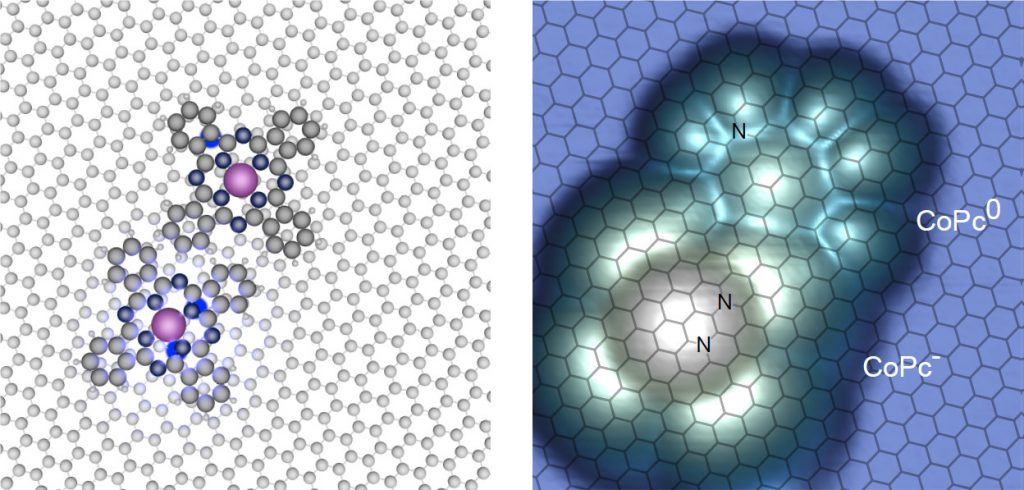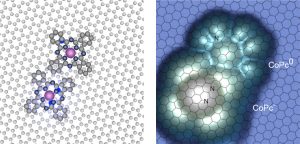Graphene is a two dimensional, material made of a carbon atomic plane, with exceptional physical properties that make it full of promises for applications in various fields. The realization of new functionalities for advanced devices is highly desirable and can be achieved by modifying the structure or chemical composition of graphene. Integrating active atomic sites in the carbon lattice for chemical reactions allows envisioning new applications for energy conversion, catalysis, chemistry or molecular electronics. In that context, particular attention has been focused on the chemical doping that consists in replacing some carbon atoms by e.g. nitrogen atoms to obtain new properties. Such a doping is expected to control the charge transfer between graphene and molecules and to achieve a redox reaction, but the direct observation of this phenomenon at the atomic scale was still needed.
This is now done with the recent work reported by researchers from the laboratoire Matériaux et Phénomènes Quantiques (MPQ, UMR 7162 CNRS/Université de Paris) and modeled by researchers in the Service de Physique de l’Etat Condensé de Saclay (SPEC, UMR 3680 CNRS/CEA) in collaboration with the Jawaharlal Nehru Centre for Advanced Research (JNCASR, Bangalore, Inde). Using a scanning tunneling microscope (STM) it has been shown that a cobalt phthalocyanine molecule (CoPc) on a nitrogen doped graphene undergoes a charge transfer ranging from a fractional to an integer electron charge. The molecule remains generally neutral (CoPc0) when located above a single nitrogen, whereas it becomes charged (CoPc-) above a nitrogen pair. Combining STM imaging, spectroscopy and molecular manipulation with ab initio calculations within the Density Functional Theory (DFT), the electronic fingerprint of a molecule as a function of the amount of charge transfer has been revealed. For a fractional charge transfer, the electronic spectrum of the molecule is rigidly shifted in energy. In an intermediate case, a splitting of the molecular states is observed. For a charged molecule, the spectrum is fully different and a series of peaks appear, corresponding to many-body effects. These results show how impurities in graphene allow to tune the charge transfer with molecules. Beside the fundamental interest of this work, the control of the charge of CoPc could have potential applications in improving its catalytic activity for reactions such as the reduction of CO2 for energy conversion.

© Jérôme Lagoute – MPQ (CNRS/Université de Paris)
Figure : Scheme (left) and STM image (right), with a lateral size of 4 nm, of two CoPc molecules on nitrogen doped graphene. The molecule located above a nitrogen pair is charged while the molecule above a single nitrogen is neutral.
Référence:
Direct observation of the reduction of a molecule on nitrogen pairs in doped graphene
M. Bouatou, S. Mondal, C. Chacon, F. Joucken, Y. Girard, V. Repain, A. Bellec, S. Rousset, S. Narasimhan, R. Sporken, Y. J. Dappe, and J. Lagoute, Nano Lett. 2020, 20, 6908−6913
https://doi.org/10.1021/acs.nanolett.0c03030
Contacts:
CNRS researchers:




